Héliciel offers an organization of the propeller design stages, allowing a flexible ergonomic design.The different phases of the design of a propeller can beings defined as: 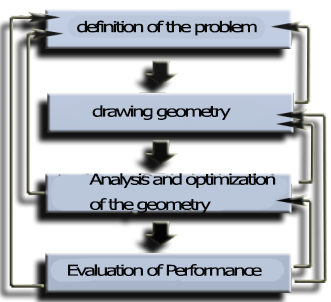
- Problem definition (Project Data) is mainly to collect the necessary data, to the definition of the operating point of the propeller.. The objective of our propeller will, depending on the project, capturing the energy of a fluid stream to turn power on the propeller shaft, or transform the power of the propeller shaft (engine power) in thrust on a fluid stream. The fluid in question may be a liquid such as water or a gas such as air.
- The design of the geometry. The geometry of the blade, of the wing, or of the propeller and the blades is effected using the known patterns, or design assumptions. For example, our design hypothesis can be: maximum blade length (lower losses blade tip), minimum thickness (performance profile of the blade) , Minimum volume of matter (weight reduction, cost and friction) , Simple Shapes (manufacturing facility) ...
- The analysis and optimization of the geometry Are related to the design of the geometry in an interactive loop , for refining and optimize the geometry in accordance with the definition of the problem. The design method should be flexible enough to allow a redefinition of the problem in case of infeasibility and incompatibility of certain parameters ....
- The performance evaluation is done by testing prototypes or models.But before you actually build the propeller, we will test it virtually by the method of blade elements. Then, new definitions of the problem, analysis, and geometry optimizations can be considered. So we design a geometry, check resistance and test its performance up to satisfaction.
In the software, for propeller and wing calculation heliciel,tabs, and a progression tree, highlight this design organization, but also allow to navigate freely between the different phases of implementation of the propeller or wing.
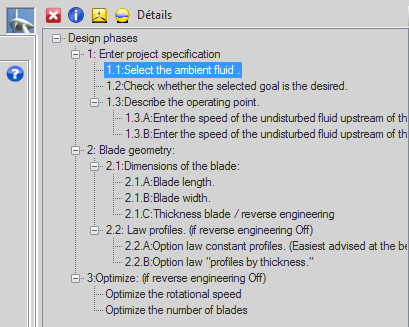
1:Project specification:

About 120 gases or liquids and their data density and viscosity according to the temperature used directly. For air the altitude will be required to adjust the density according to the pressure.

4 types of studies and goals are achievable with Heliciel:
- Propulsion propellers (boat propellers, propeller aircraft, helicopters propellers ...)
- Propellers pressure based on flow (propeller ventilation propellers axial pump ...)
- Propellers energy harvesting (aeroengine, wind turbines, tidal turbine , turbine axial Kaplan ...)
- Wings and foils (wings, fins, foils, hydrofoils, sails, fins, rudders, rudder, airships, hull ...)
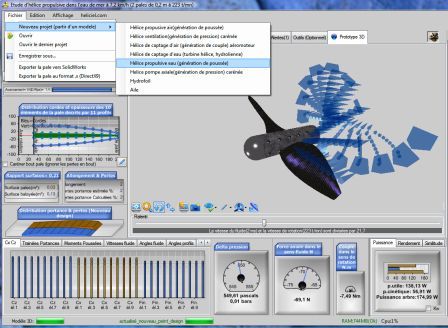
Fluid velocity (or from the vehicle) and the desired rotational speed (if known, otherwise the optimum speed will be proposed).
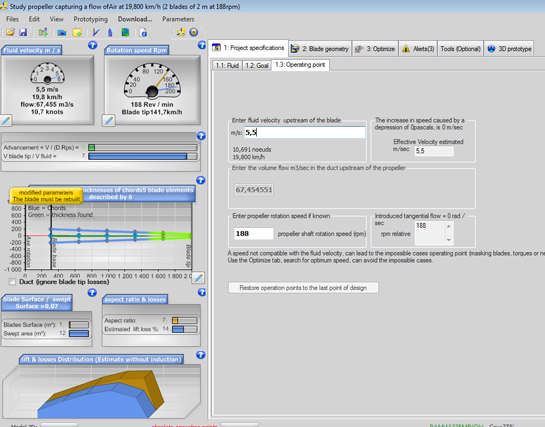
2 The geometry of the blade or wing:

In the blade dimensions tab, a series of sliders allows you to model the shape of the blade or wing in all its dimensions. (see chords distribution and thickness distribution)

2.2:Law of automatic selection of profiles in the database
![]() Héliciel uses its database performance profiles to choose the optimum profiles, corresponding to the operating conditions and the geometry of your blade or wing.
Héliciel uses its database performance profiles to choose the optimum profiles, corresponding to the operating conditions and the geometry of your blade or wing.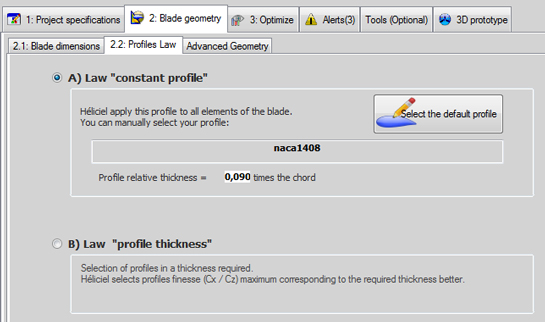
- A: Law constant profiles: Heliciel applies the form of profile you have selected all along the blade. The thickness of the blade is connected with the chord (width) of the blade.. This law of selection is the simplest and is highly recommended for beginners.
- B:Law of the thickness profile: This profile law allows you to choose the evolution of the thickness along the blade, the profiles will therefore be of different shapes. Héliciel searches for and selects the optimum performance profiles corresponding best to the desired thickness. This profile law requires a little more experience because it often involves discontinuities of shapes and incidences which will have to be managed using functions smoothing of incidences and forcing of profile shapes.
(Advanced features are optional and the beginner can ignorer)It is possible to determine the material and the building structure of the blade or wing. These parameters are used to calculate the resistance of the blade elements, and allow you to choose your material construction.
Structure and material of the blade (advanced geometry function):The blade or wing may be of various structures :
- rib 1,2,3, or 4 beams
- full
- hull
- round tube frame
- square tube frame

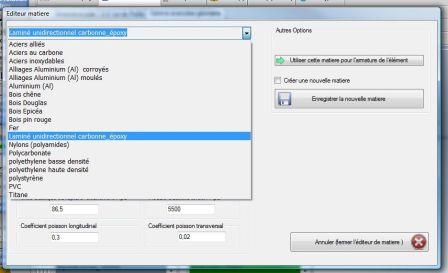
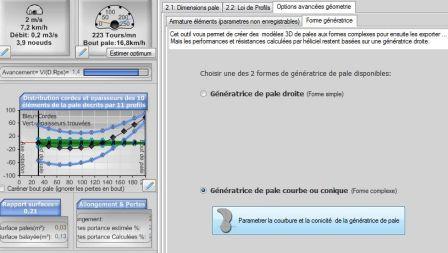
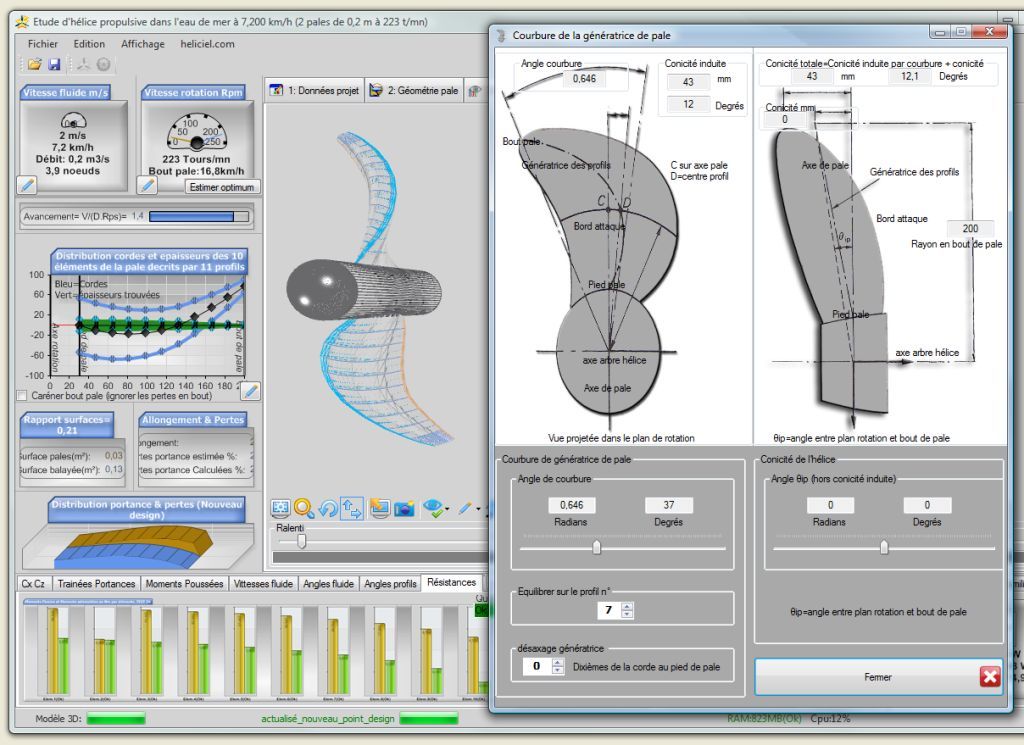
The blades of generating curvature is not considered in the calculation of performance and resistance. The blades straight or curved generatrices have the same resistance and performance, as in the blade of curvature actually affects these parameters.
3:Optimize.The tab "Optimize" includes optimum speed search functions. The number of blade can be changed and tested. The influence of the number of blades on the rotational speed with the best performance, is thus demonstrated.
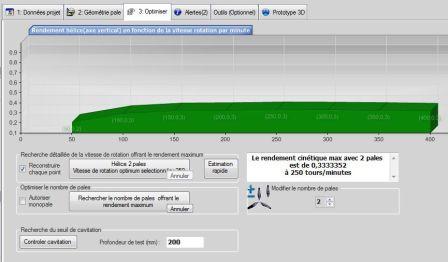
For a more detailed description of the functions of HELICIEL:Heliciel details!
tutorials: tutorials HELICIEL

 Global site map
Global site map Mecaflux
Mecaflux Tutorials Mecaflux Pro3D
Tutorials Mecaflux Pro3D Tutorials Heliciel
Tutorials Heliciel Mecaflux Store
Mecaflux Store Compare software functions
Compare software functions Quotes, Orders, Payment Methods
Quotes, Orders, Payment Methods project technical studies
project technical studies